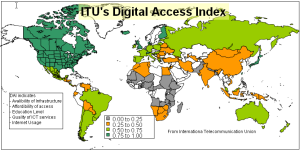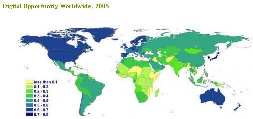...
In 2003, the ITU's Market, Economics and Finance Unit launched the Digital Access Index (DAI), a new index, which measures the overall ability of individuals in a country to access and use new ICTs. The DAI is built around four fundamental vectors that impact a country's ability to access ICTs: infrastructure, affordability, knowledge and quality and actual usage of ICTs. The DAI has been calculated for ~180 economies where European countries were among the highest ranked. The DAI allows countries to see how they compare to peers and their relative strengths and weaknesses. The DAI also provides a transparent and globally measurable way of tracking progress towards improving access to ICTs." from http://www.itu.int/ITU-D/ict/dai/. In 2005 the ITU launched the Digital Opportunity Index(DOI) The DoI evaluates the opportunity, infrastructure and utilization of Information and Communication Technologies (ICTs) for 180 economies worldwide. The Index monitors the mobile communications that promise to bridge the digital divide in many parts of the world, as well as more recent technologies such as broadband and mobile Internet access.The right hand map above shows the DOI coverage and values worldwide.
Comparison of TCP Throughput with the Network Readiness Index (NRI) 2006-2007
The Network Readiness Index (NRI) comes from the "The Global Information Technology Report 2006-2007" of the World Economic Forum. NRI measures the degree of preparation of a nation or community to participate in and benefit from ICT developments. The NRI is composed of three component indexes which assess:
- environment for ICT offered by a country or community
- readiness of the community's key stakeholders (individuals, business and governments)
- usage of ICT among these stakeholders.
A map of the NRI for the 122 countries of the 2006-2007 NRI are shown in the map below.

